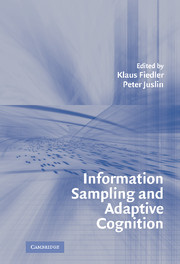Book contents
- Frontmatter
- Contents
- List of Contributors
- PART I INTRODUCTION
- PART II THE PSYCHOLOGICAL LAW OF LARGE NUMBERS
- 2 Good Sampling, Distorted Views: The Perception of Variability
- 3 Intuitive Judgments about Sample Size
- 4 The Role of Information Sampling in Risky Choice
- 5 Less Is More in Covariation Detection – Or Is It?
- PART III BIASED AND UNBIASED JUDGMENTS FROM BIASED SAMPLES
- PART IV WHAT INFORMATION CONTENTS ARE SAMPLED?
- PART V VICISSITUDES OF SAMPLING IN THE RESEARCHER'S MIND AND METHOD
- Index
- References
3 - Intuitive Judgments about Sample Size
Published online by Cambridge University Press: 02 February 2010
- Frontmatter
- Contents
- List of Contributors
- PART I INTRODUCTION
- PART II THE PSYCHOLOGICAL LAW OF LARGE NUMBERS
- 2 Good Sampling, Distorted Views: The Perception of Variability
- 3 Intuitive Judgments about Sample Size
- 4 The Role of Information Sampling in Risky Choice
- 5 Less Is More in Covariation Detection – Or Is It?
- PART III BIASED AND UNBIASED JUDGMENTS FROM BIASED SAMPLES
- PART IV WHAT INFORMATION CONTENTS ARE SAMPLED?
- PART V VICISSITUDES OF SAMPLING IN THE RESEARCHER'S MIND AND METHOD
- Index
- References
Summary
Suppose a state election is coming up in a certain European country and somebody asks you if you would bet on whether the Social Democrats will beat the Christian Democrats again as they did in the last election. Shortly before Election Day, you are presented the results of two opinion polls, based on random samples of either 100 or 1,000 voters. In the smaller sample, the Social Democrats have an advantage of 4 percentage points whereas in the larger sample, the Christian Democrats lead by the same amount. Would you take the bet? You probably would not and I assume that this would be the choice of most people asked this question. As we will see later, your choice would be justified on both empirical and theoretical grounds.
This chapter offers an explanation for how and when the “naïve intuitive statistician” (Fiedler & Juslin, this volume) understands the impact that the size of a sample should have on estimates about population parameters such as proportions or means. I will argue that, in general, people know intuitively that larger (random) samples yield more exact estimates of population means and proportions than smaller samples and that one should have more confidence in these estimates the larger the size of the sample. My main claim is that the size-confidence intuition – an intuition that properly captures the relationship between sample size and accuracy of estimates – governs people's judgments about sample size. This intuition can be regarded as the result of associative learning.
- Type
- Chapter
- Information
- Information Sampling and Adaptive Cognition , pp. 53 - 71Publisher: Cambridge University PressPrint publication year: 2005
References
- 1
- Cited by



